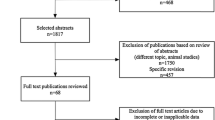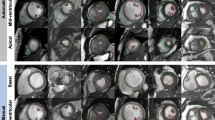Abstract
Purpose
MRI is considered reference standard for the assessment of left ventricular (LV) volume and mass measurements. There are few accepted guidelines for uniform assessment of cardiac function with MRI. We sought to investigate different confounding factors influencing LV measurement results.
Material and Methods
In 60 diabetic type-II patients (group A) we compared intra-/inter-reader variability of MRI for cardiac function measured twice at a 3 month interval by one MRI trained reader and one untrained. In 20 patients (group B) two different techniques were compared for determining the epicardial and endocardial LV-borders.
Results
Bland Altman analysis showed excellent intra-observer measurement agreement for the trained reader 1 for EDM (mean=–2.3 (–23.6–19)), EDV (2.9(–9.2–15.0)), ESV (3.3(–5.8–12.4)) and EF (1.2(–3.3–5.7)). Untrained reader 2 measurement agreement was considerably less appropriate for EDM (mean=–8.2 (–25.8–9.5)), EDV (7.8(–5.1–20.7)), ESV (5.3(–8.0–18.6)). Only for EF (0.8 (–6.5–8.1)) results were comparable to reader 1. Inter-observer measurement in the beginning was poor for EDM (–13.5(–55.6–28.6)) and EDV (7.3(–61.9–76.6)), whereas agreement for ESV (2.1(–29.9–34.2)) and EF (–0.9(–11.6–9.9)) was good. After 3 months, measurement agreement for EDM (–5.3 (–46.4–35.8)) was considerably improved, for EDV (0.4(–67.0–66.2)) was excellent, whereas agreement for ESV (3.1(–34.4–28.1)) and EF (–1.7(–13.0–9.6)) was similar. Using different techniques for determining the epicardial and endocardial borders, only end-diastolic volume was unchanged whereas all other parameters were significantly different using the two methods (p ≤ 0.03).
Conclusion
Intra- and inter-reader variability, analyst experience as well as different techniques for determining the boundaries of the left ventricle significantly affect MRI parameters for cardiac function. These results suggest a need for developing commonly accepted standards for cardiac MRI evaluation.
Similar content being viewed by others
References
Allison JD, Flickinger FW, Wright JC, Falls DG 3rd, Prisant LM, VonDohlen TW, Frank MJ (1993) Measurement of left ventricular mass in hypertrophic cardiomyopathy using MRI: comparison with echocardiography. Magn Reson Imaging 11(3):329–334
Bellenger NG, Davies LC, Francis JM, Coats AJ, Pennell DJ (2000) Reduction in sample size for studies of remodeling in heart failure by the use of cardiovascular magnetic resonance. J Cardiovasc Magn Reson 2(4):271–278
Bellenger NG, Grothues F, Smith GC, Pennell DJ (2000) Quantification of right and left ventricular function by cardiovascular magnetic resonance. Herz 25(4):392–399
Doherty NE 3rd, Seelos KC, Suzuki J, Caputo GR, O’Sullivan M, Sobol SM, Cavero P, Chatterjee K, Parmley WW, Higgins CB (1992) Application of cine nuclear magnetic resonance imaging for sequential evaluation of response to angiotensin-converting enzyme inhibitor therapy in dilated cardiomyopathy. J Am Coll Cardiol 19(6):1294–1302
Dunn FG, Pringle SD (1993) Sudden cardiac death, ventricular arrhythmias and hypertensive left ventricular hypertrophy. J Hypertens 11(10):1003–1010 (Review)
Francis J, Moon J, Smith G et al (2001) The benefit of TrueFISP versus FLASH imaging in patients with poor left ventricular function (abstr). Proceedings of the Fourth Annual Meeting of the Society for Cardiovascular Magnetic Resonance, pp 99–100
Ghali JK, Liao Y, Simmons B, Castaner A, Cao G, Cooper RS (1992) The prognostic role of left ventricular hypertrophy in patients with or without coronary artery disease. Ann Intern Med 117(10):831–6
Gordon EP, Schnittger I, Fitzgerald PJ, Williams P, Popp RL (1983) Reproducibility of left ventricular volumes by two-dimensional echocardiography. J Am Coll Cardiol 2(3):506–513
Hecht HS, Karahalios SE, Ormiston JA, Schnugg SJ, Hopkins JM, Singh BN (1982) Patterns of exercise response in patients with severe left ventricular dysfunction: radionuclide ejection fraction and hemodynamic cardiac performance evaluations. Am Heart J 104(4 Pt 1):718–24
Higgins CB (1992) Which standard has the gold? J Am Coll Cardiol 19(7):1608–1609
Khaled A, Plein S, Thiele H, Jones T, Ridgway JT, Sivananthan MU (2003) Normal Human Left and Right Ventricular Dimensions for MRI as Assessed by Turbo Gradient Echo and Steady State Free Precession Imaging Sequences. J Magn Reson Imaging 17:323–329
Koren MJ, Devereux RB, Casale PN, Savage DD, Laragh JH (1991) Relation of left ventricular mass and geometry to morbidity and mortality in uncomplicated essential hypertension. Ann Intern Med 114(5):345–352
Kronik G, Slany J, Mosslacher H (1979) Comparative value of eight Mmode echocardiographic formulas for determining left ventricular stroke volume. A correlative study with thermodilution and left ventricular single-plane cineangiography. Circulation 60(6):1308–1316
Levine TB, Levine AB, Keteyian SJ, Narins B, Lesch M (1997) Reverse remodeling in heart failure with intensification of vasodilator therapy. Clin Cardiol 20(8):697–702
Levy D, Garrison RJ, Savage DD, Kannel WB, Castelli WP (1990) Prognostic implications of echocardiographically determined left ventricular mass in the Framingham Heart Study. N Engl J Med 322(22):1561–1566
Li W, Stern JS, Mai VM, Pierchala LN, Edelman RR, Prasad PV (2002) MR assessment of left ventricular function: quantitative comparison of fast imaging employing steady-state acquisition (FIESTA) with fast gradient echo cine technique. J Magn Reson Imaging 16(5):559–564
Longmore DB, Klipstein RH, Underwood SR, Firmin DN, Hounsfield GN, Watanabe M, Bland C, Fox K, Poole-Wilson PA, Rees RS et al (1985) Dimensional accuracy of magnetic resonance in studies of the heart. Lancet 1(8442):1360–1362
Lorenz CH, Walker ES, Morgan VL, Klein SS, Graham TP Jr (1999) Normal human right and left ventricular mass, systolic function, and gender differences by cine magnetic resonance imaging. J Cardiovasc Magn Reson 1(1):7–21
Mogelvang J, Stokholm KH, Saunamaki K, Reimer A, Stubgaard M, Thomsen C, Fritz-Hansen P, Henriksen O (1992) Assessment of left ventricular volumes by magnetic resonance in comparison with radionuclide angiography, contrast angiography and echocardiography. Eur Heart J 13(12):1677–1683
Moon JC, Lorenz CH, Francis JM, Smith GC, Pennell DJ (2002) Breathhold FLASH and FISP cardiovascular MR imaging: left ventricular volume differences and reproducibility. Radiology 223(3):789–797
Pattynama PM, Lamb HJ, van der Velde EA, van der Wall EE, de Roos A (1993) Left ventricular measurements with cine and spin-echo MR imaging: a study of reproducibility with variance component analysis. Radiology 187(1):261–268
Plein S, Bloomer TN, Ridgway JP, Jones TR, Bainbridge GJ, Sivananthan MU (2001) Steady-state free precession magnetic resonance imaging of the heart: comparison with segmented k-space gradient-echo imaging. J Magn Reson Imaging 14(3):230–236
White HD, Norris RM, Brown MA, Brandt PW, Whitlock RM, Wild CJ (1987) Left ventricular end-systolic volume as the major determinant of survival after recovery from myocardial infarction. Circulation 76(1):44–51
Author information
Authors and Affiliations
Corresponding author
Rights and permissions
About this article
Cite this article
Steen, H., Nasir, K., Flynn, E. et al. Is Magnetic Resonance Imaging the 'Reference Standard' for Cardiac Functional Assessment? Factors Influencing Measurement of Left Ventricular Mass and Volumes. Clin Res Cardiol 96, 743–751 (2007). https://doi.org/10.1007/s00392-007-0556-2
Received:
Accepted:
Published:
Issue Date:
DOI: https://doi.org/10.1007/s00392-007-0556-2




